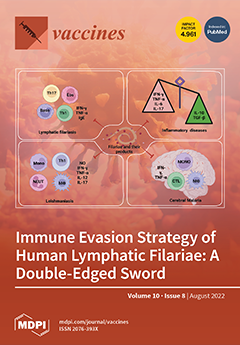Longitudinal data regarding the serotype distribution and antimicrobial susceptibility of
S. pneumoniae-causing invasive pneumococcal disease (IPD) in developing countries are limited. Our aim was to monitor the antimicrobial susceptibility, serotype distribution, and serotype coverage rates of the pneumococcal conjugate vaccines (PCVs) and
[...] Read more.
Longitudinal data regarding the serotype distribution and antimicrobial susceptibility of
S. pneumoniae-causing invasive pneumococcal disease (IPD) in developing countries are limited. Our aim was to monitor the antimicrobial susceptibility, serotype distribution, and serotype coverage rates of the pneumococcal conjugate vaccines (PCVs) and emerging non-vaccine serotypes (NVT) between 2012 and 2016 in central Thailand. Pneumococcal isolates from sterile specimens of patients, collected within a long-standing collaborative hospital network in central Thailand between 2012 and 2016, were studied. The pneumococcal serotypes included in the 15-valent PCV were identified by the quellung reaction, while the non-PCV15 serotypes were identified by multiplex PCR. Antimicrobial susceptibilities were determined by the microbroth dilution or disk diffusion method. Of the 276 pneumococcal isolates, 129 (46.7%) were from children aged ≤5 years. Only 9.0% of patients with available data received the PCV prior to the onset of the IPD. The most common vaccine serotypes were 6B (17.4%), 19A (13.0%), and 14 (11.2%), respectively. Non-PCV15 serotypes were detected in 27.9%; the most common serotypes were 15B/C (5.1%), 15A/F (4.0%), and 23A (3.6%), respectively. The serotype coverage rates of PCV10 in children aged ≤5 years was 55.8%, and 53.3% across all ages. PCV13 provided similar coverage rates to that of PCV15, 71.3% in children aged ≤5 years, and 72.1% across all ages. High susceptibilities to cefotaxime (94.6%), ofloxacin (98.2%), linezolid (99.6%), and vancomycin (100.0%) were observed, while the susceptibility to erythromycin (50.0%), TMP-SMZ (41.3%), and tetracycline (27.2%) were low. The susceptibilities to penicillin, meropenem, and clindamycin were 85.9%, 85.9%, and 84.8%, respectively. Serotype 19A was associated with a lower susceptibility than the non-19A isolates for penicillin (75.0% vs. 87.5%,
p = 0.045), meropenem (52.8% vs. 90.8%,
p < 0.001), erythromycin (33.3% vs. 53.8%,
p = 0.022), and TMP-SMZ (16.7% vs. 45.0%,
p = 0.001). Although the majority of the pneumococcal serotypes causing IPD in central Thailand were covered by the currently available PCVs, 25% of IPD were caused by NVT. Several emerging NVT identified were 15B/C, 15A/F, and 23A. The high rates of resistance to penicillin, meropenem, erythromycin, TMP-SMZ, and tetracycline observed is a major concern. Serotype 19A was associated with lower antimicrobial susceptibilities in comparison to the non-19A serotypes.
Full article






